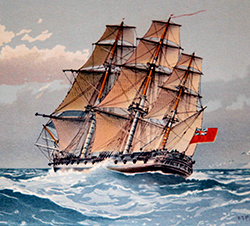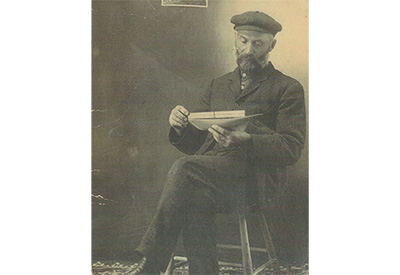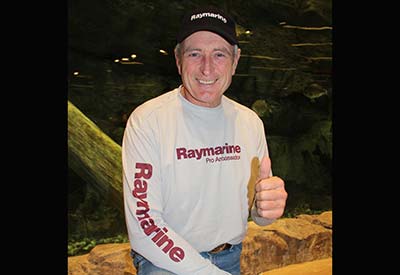Heritage Pt 3 – 1814 – War on the Upper Lakes

Article: John Jamieson
The United States strategic plan for 1814 was to gain control of Lake Ontario, capture Burlington and York then retake Fort Niagara. That didn’t happen. The intent on the Upper Lakes was to retake Michilimackinac and the destruction of the North West Company trading posts and the two brigs being built up the river at Matchedash. The British goal on the Upper Lakes to protect the fur trade, its supporting infrastructure and the Indian alliances remained unchanged throughout the War.
The only British ships left on the Upper Lakes after the American victory on Lake Erie in 1813 were the lightly armed North West Company supply schooners Nancy, Perseverance and Mink. No British naval presence meant that Michilimackinac, captured from the Americans at the beginning of the War, had become more vulnerable to attack. Early in 1814 General Prevost, ordered Lt. Col McDouall of the Glengarry Light Infantry Fencibles, to strengthen Michilimackinac’s defences. Leaving Kingston in February 1814 with 10 officers, 220 infantry and artillerymen and 20 seamen he travelled to York and up the overland route to Lake Simcoe and the Nottawasaga River. Here he established a camp (Fort Willow) and proceeded to construct 29 bateaux. This small fleet left for Michilimackinac with supplies and the reinforcements at the end of April, arriving on the 18th of May with the loss of only one boat. McDouall lost no time in strengthening the defences, including building a blockhouse to command the high ground. This effort was not lost on the natives and resulted in a further strengthening of the ties between them and the British.
Captain Sinclair, following his orders to execute the Upper Lakes plan, took 600-700 troops and the brigs Niagara, Lawrence, Caledonia and General Hunter and schooners Tigress, Scorpion and Ohio into Lake Huron in July. They proceeded directly to Matchedash where American intelligence indicated that British brigs were being built up a river. Intelligence likely had confused Matchedash with the Nottawasaga River as there was nothing at Matchedash other than a small trading post. In any event Sinclair did not even find that, as he lacked charts or local knowledge and was unable to navigate the myriad of rocks in the fog. Giving up, he sailed northwards to Fort St. Joseph’s at the top of Lake Huron but as it had been abandoned when the British moved the garrison to Michilimackinac, Sinclair had to be satisfied with burning what was left. He sent a raiding party up the St. Mary’s River to take care of the North West Company’s trading post at Sault Ste. Marie. The destruction of it, and the adjacent homes and crops, was accomplished without resistance. A plus was the discovery of the schooner Perseverance, although she was wrecked when the Americans attempted to bring her down through the rapids into Lake Huron. In the meantime, Mink, a small Northwest Company trading company schooner, had sailed past St. Joseph’s and was captured. This proved to be particularly beneficial as a crew member informed Sinclair that the Matchedash site he was looking for was actually up the Nottawasaga River.

The fleet anchored off Michilimackinac on 26 July but for some reason the Americans did not attempt a landing until the 4th of August. This gave McDouall time to prepare for the attack and send a message to Lt Worsley to hide Nancy up the river and construct a blockhouse on shore to protect her. The attack on Michilimackinac was unsuccessful and Commodore Sinclair sent most of his ships back to Lake Erie, keeping Niagara, Scorpion and Tigress to search for Nancy.
The Nottawasaga River parallels the shore for several miles and was a poor place to hide as the trees did not completely conceal Nancy’s topmasts. The Americans found her on the 14th of August, landed a shore battery. When the battery and ships opened fire, it wasn’t long before Lt Worsley realized that he was greatly outnumbered, blew up Nancy and the supporting blockhouse and retired upriver towards his supply depot. Having accomplished his mission, Commodore Sinclair returned to Lake Erie in Niagara, leaving Scorpion and Tigress to blockade the mouth of the Nottawasaga River until the end of the navigation season, survey the Lake as far east as Matchedash Bay and intercept trade canoes travelling between the St. Mary’s and French Rivers. This was a tall order for two ships to accomplish in the three months or so left to them in the navigation season. In any event they didn’t get the chance to do much as an August storm forced them to run northwards for shelter, which allowed Lt Worsley to leave with supplies for Michilimackinac. His canoe and two heavily laden bateaux arrived at Detour Passage to find Scorpion and Tigress at anchor. Lt Worsley hid the bateaux, waited for dark and slipped past in the canoe. He returned with reinforcements from Michilimackinac to cut out the schooners. Scorpion had sailed but Tigress was surprised and captured. The same fate befell Scorpion on her return (she was unaware that Tigress had been captured as the Stars and Stripes had been left flying – the last time this flag was seen on the Upper Lakes during the war). Lt Worsley felt that he had got the better part of the deal having traded Nancy for two war ships.
Scorpion and Tigress, renamed HMS Confiance and Surprize (Surprise) lived out their days in the Royal Navy. Initially based at Nottawasaga, they moved to the Lake Erie Grand River Naval Depot in 1817 to relieve Tecumseth and Newash which had been transferred to Penetanguishene. Placed in ordinary (not operational) in 1818, they quietly rotted away. Surprize was badly damaged in 1827 when a storm washed away her wharf along with her master, two hands and a boy. Both ships were condemned soon afterwards and scuttled off the mouth of the Grand River. Tecumseth met the same fate about the same time and her remains, raised from Penetanguishene Bay in 1953, are on display at Discovery Harbour. Tecumseth was never joined by the frigate that was just begun at Penetanguishene as work was stopped when peace broke out. Nothing remains of her but an anchor, abandoned at Soldier’s Bay Lake Simcoe as it was being dragged up from York in the winter of 1815. It can still be seen at Anchor Park, Holland Landing.
In 1817, the Rush-Bagot Agreement signed between Britain and the United States limited each nation to two warships of less than 100 tons on the Upper Lakes. This lead to the construction of smaller vessels such as the schooner Bee (full sized replicas of Bee and Tecumseth are berthed at Discovery Harbour). Steve Killing designed the Bee replica and he will be available to describe how he used modern design methods to incorporate 19th century technology and appearance. For those more interested in the present than the past, his talk on fast yachts will explore the fascinating cutting edge of go fast yacht design.
DINNER TICKETS ARE $75 EACH AND AVAILABLE AT THE MUSEUM UNTIL 30 APRIL. AS THIS IS A FUNDRAISER, A $40 TAX RECEIPT WILL BE PROVIDED WITH EACH TICKET. FOR MORE INFORMATION CALL THE HURONIA MUSEUM AT 705-526-2844.
Huronia Heritage Evening Info Here
Read Part 1 of Heritage Series | Read Part 2 of Heritage Series
Photo 1: The frigate jpg is a watercolour of a Napoleonic War frigate which is representative of the frigates on Lake Ontario towards the end of the War. – Courtesy John Jamieson
Photo 2: HMS St.Lawrence – The St. Lawrence model is located at RMC. – Courtesy Huronia Museum





























